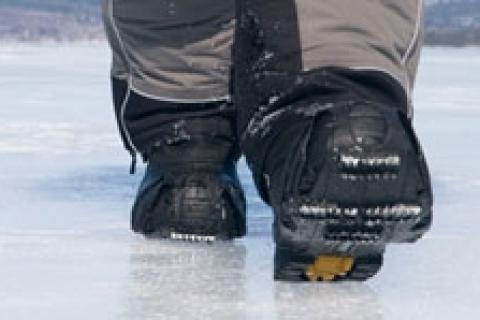
 I've been out on several productive panfish ice outings recently. Black crappie have been the target species on most, although bluegills and yellow perch were also in my crosshairs at times. A reoccurring theme on these adventures was that once I dialed-in fish whereabouts I caught a lot more of them by hole-hopping around and saturating the productive area. One outing illustrates this particularly well.
I've been out on several productive panfish ice outings recently. Black crappie have been the target species on most, although bluegills and yellow perch were also in my crosshairs at times. A reoccurring theme on these adventures was that once I dialed-in fish whereabouts I caught a lot more of them by hole-hopping around and saturating the productive area. One outing illustrates this particularly well.
I was one of four anglers working over a fairly large area on a small, pothole lake. We began our efforts at the edge of the basin and worked in, drilling and fishing up the main drop-off, then onto a 16-foot soft-bottom flat that rose and eventually intersected a shallow, weedy bay. Peppering holes in zigzag and starburst patterns, we'd fish them quickly until we contacted fish — an iced crappie the signal to explore the immediate area. What was fascinating was that a handful of times one angler would be hauling up crappie hand over fist while another 15 to 20 feet away would experience slow or no action at all. That was until they moved closer to the hot hole.
My ice fishing memories are ripe with such examples where fine-tuning my position has put me on biting fish. If you think of it, every ice hole represents a cast, and just like the warmer months, it's critical to dissect areas with lot of casts (i.e., holes) to discover nuances that concentrate fish. Find an isolated rocky finger or point extending off of a mid-lake hump and you've likely intercepted the lead-in that walleye, pike and other species will use to move on and off of the structure. In a similar vein, a sunken tree or brush pile has a knack for calling in crappie on barren flats and bays.
Scouting during open-water is a great way to pinpoint the type of features that will concentrate fish. Storing them as waypoints will let you return come ice. When exploring a new system in winter, paying attention to your electronics will serve you well. Variations in depth, soft-versus-hard bottom signals, and weeds are all clues you may be near a fish-holding hotspot. Another awesome tool is an underwater camera; they take the guess work out of what's below and deliver a real-time moving picture.
Don't forget to put boots to ice and keep drilling holes on your next outing. It can be a bit of a winter workout, but it's one of the most reliable ways to rack up lot of fish in a day.
- 2370 views

